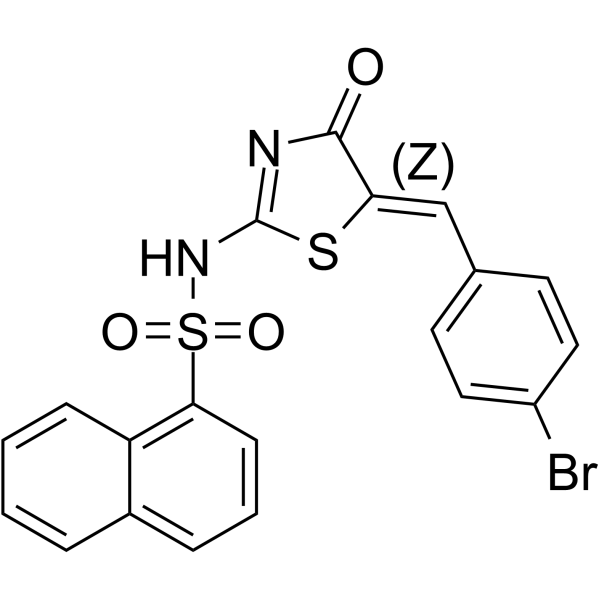Physicochemical Properties
| Molecular Formula | C20H13BRN2O3S2 |
| Molecular Weight | 473.362821340561 |
| Exact Mass | 471.955 |
| CAS # | 1419320-73-2 |
| Related CAS # | Clathrin-IN-1;1332879-52-3 |
| PubChem CID | 136246422 |
| Appearance | Yellow to brown solid powder |
| LogP | 5.5 |
| Hydrogen Bond Donor Count | 1 |
| Hydrogen Bond Acceptor Count | 5 |
| Rotatable Bond Count | 3 |
| Heavy Atom Count | 28 |
| Complexity | 767 |
| Defined Atom Stereocenter Count | 0 |
| SMILES | C1(C=CC=C2C=CC=CC=12)S(=O)(=O)NC1S/C(=C\C2C=CC(Br)=CC=2)/C(=O)N=1 |
| InChi Key | CGDLWHGPJPVPDU-ATVHPVEESA-N |
| InChi Code | InChI=1S/C20H13BrN2O3S2/c21-15-10-8-13(9-11-15)12-17-19(24)22-20(27-17)23-28(25,26)18-7-3-5-14-4-1-2-6-16(14)18/h1-12H,(H,22,23,24)/b17-12- |
| Chemical Name | (NZ)-N-[(5Z)-5-[(4-bromophenyl)methylidene]-4-oxo-1,3-thiazolidin-2-ylidene]naphthalene-1-sulfonamide |
| Synonyms | Pitstop 2; Clathrin-IN-1; (NZ)-N-[(5Z)-5-[(4-bromophenyl)methylidene]-4-oxo-1,3-thiazolidin-2-ylidene]naphthalene-1-sulfonamide; 1419093-54-1; (Z)-N-(5-(4-Bromobenzylidene)-4-oxo-4,5-dihydrothiazol-2-yl)naphthalene-1-sulfonamide; 1419320-73-2; 4g55; 1332879-52-3; |
| HS Tariff Code | 2934.99.9001 |
| Storage |
Powder-20°C 3 years 4°C 2 years In solvent -80°C 6 months -20°C 1 month Note: This product requires protection from light (avoid light exposure) during transportation and storage. |
| Shipping Condition | Room temperature (This product is stable at ambient temperature for a few days during ordinary shipping and time spent in Customs) |
Biological Activity
| Targets | CME/clathrin-mediated endocytosis |
| ln Vitro | Pitstop 2 (20–40 μM; 30 min) prevents J774A.1 macrophages from endocytosing transferrin while maintaining cell viability[1]. Pitstop 2 (20–40 μM; 30 min) has no effect on J774A.1 macrophages' ability to internalize cholera toxin B[1]. Pitstop 2 (0.001-100 μM; 6 h) inhibits the spindle of HeLa cells, preventing them from progressing through mitosis[2]. Pitstop 2 (1-30 μM; 24 h) inhibits the growth of dividing cancer cells and causes apoptosis[2]. Pitstop 2 (1-30 μM; 48 h) has no effect on non-tumourigenic NIH3T3 fibroblasts' ability to proliferate and remain viable[2]. |
| Cell Assay |
Cell Viability Assay[2] Cell Types: HeLa cells Tested Concentrations: 1, 3, 10, 30 μM Incubation Duration: 24 hrs (hours) Experimental Results: decreased the total number of viable HeLa cells markedly in a dose-dependent manner. |
| References |
[1]. Leishmania donovani Internalizes into Host Cells via Caveolin-mediated Endocytosis. Sci Rep. 2019 Sep 2; 9(1): 12636. [2]. Inhibition of clathrin by pitstop 2 activates the spindle assembly checkpoint and induces cell death in dividing HeLa cancer cells. Mol Cancer. 2013 Jan 17; 12:4. |
| Additional Infomation |
Leishmania donovani is an intracellular protozoan parasite that causes visceral leishmaniasis, a major cause of mortality and morbidity worldwide. The host plasma membrane serves as the portal of entry for Leishmania to gain access to the cellular interior. Although several host cell membrane receptors have been shown to be involved in the entry of Leishmania donovani into host cells, the endocytic pathway involved in the internalization of the parasite is not known. In this work, we explored the endocytic pathway involved in the entry of Leishmania donovani into host macrophages, utilizing specific inhibitors against two major pathways of internalization, i.e., clathrin- and caveolin-mediated endocytosis. We show that pitstop 2, an inhibitor for clathrin-mediated endocytosis, does not affect the entry of Leishmania donovani promastigotes into host macrophages. Interestingly, a significant reduction in internalization was observed upon treatment with genistein, an inhibitor for caveolin-mediated endocytosis. These results are supported by a similar trend in intracellular amastigote load within host macrophages. These results suggest that Leishmania donovani utilizes caveolin-mediated endocytosis to internalize into host cells. Our results provide novel insight into the mechanism of phagocytosis of Leishmania donovani into host cells and assume relevance in the development of novel therapeutics against leishmanial infection.[1] Background: During metaphase clathrin stabilises the mitotic spindle kinetochore (K)-fibres. Many anti-mitotic compounds target microtubule dynamics. Pitstop 2™ is the first small molecule inhibitor of clathrin terminal domain and inhibits clathrin-mediated endocytosis. We investigated its effects on a second function for clathrin in mitosis. Results: Pitstop 2 did not impair clathrin recruitment to the spindle but disrupted its function once stationed there. Pitstop 2 trapped HeLa cells in metaphase through loss of mitotic spindle integrity and activation of the spindle assembly checkpoint, phenocopying clathrin depletion and aurora A kinase inhibition. Conclusions: Pitstop 2 is therefore a new tool for investigating clathrin spindle dynamics. Pitstop 2 reduced viability in dividing HeLa cells, without affecting dividing non-cancerous NIH3T3 cells, suggesting that clathrin is a possible novel anti-mitotic drug target.[2] |
Solubility Data
| Solubility (In Vitro) | DMSO : 62.5 mg/mL (132.03 mM) |
| Solubility (In Vivo) |
Solubility in Formulation 1: ≥ 2.5 mg/mL (5.28 mM) (saturation unknown) in 10% DMSO + 40% PEG300 +5% Tween-80 + 45% Saline (add these co-solvents sequentially from left to right, and one by one), clear solution. For example, if 1 mL of working solution is to be prepared, you can add 100 μL of 25.0 mg/mL clear DMSO stock solution to 400 μL PEG300 and mix evenly; then add 50 μL Tween-80 + to the above solution and mix evenly; then add 450 μL normal saline to adjust the volume to 1 mL. Preparation of saline: Dissolve 0.9 g of sodium chloride in 100 mL ddH₂ O to obtain a clear solution. (Please use freshly prepared in vivo formulations for optimal results.) |
| Preparing Stock Solutions | 1 mg | 5 mg | 10 mg | |
| 1 mM | 2.1126 mL | 10.5628 mL | 21.1256 mL | |
| 5 mM | 0.4225 mL | 2.1126 mL | 4.2251 mL | |
| 10 mM | 0.2113 mL | 1.0563 mL | 2.1126 mL |
